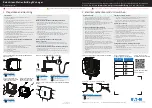
Hints for Driving
Aquaplaning
Brakes
Power assistance
When the engine is not running, both
the service brake and the steering are
without power assistance. Under these
circumstances, a much greater effort is
necessary to steer or stop the vehicle.
Tires
Do not allow your tires to wear down
too far. With less than 3 mm/'/e in of
tread, the antiskid properties on a wet
road are sharply reduced.
Depending upon the weather and/or
road pavement, the traction varies
widely.
Specified tire pressures must be main
tained. This applies particularly if the
tires are subjected to high loads (e.g.
high speeds, heavy loads, high
ambient temperatures).
Depending on the depth of the water
layer on the road, aquaplaning may
occur, even at low speeds. Avoid track
grooves in the road and apply brakes
cautiously in the rain.
Tire friction
A given speed at which a vehicle driven
on dry roads can still be fully controlled
must be reduced when the same vehi
cle is to be driven safely on a wet or icy
road.
You should pay particular attention to
the condition of the road as soon as the
prevailing temperatures fall close to the
freezing point.
If ice has formed on the road, tire trac
tion will be substantially reduced.
Under such weather conditions, drive,
steer and brake particularly carefully.
We recommend M+S-radial-ply tires
for the cold season. On packed snow,
they can reduce your stopping distance
as compared with summer tires. Stop
ping distance, however, is nevertheless
considerably greater than when the
road is wet or dry.
When driving down long and steep
declines, relieve the brakes by shifting
into a lower speed (selector lever posi
tion “3” or “2" in the case of automatic
transmissions). This prevents over
heating of the brakes and reduces
brake pad wear.
After hard braking it is advisable to
drive on for some time so the air
stream will cool down the brakes
faster.
When driving in heavy rain for some
time without applying the brakes, the
first braking action may be somewhat
reduced and increased pedal pressure
may be necessary. For this reason,
stay further away from vehicle in front.
The condition of the parking brake sys
tem is checked each time the car is in
the shop for maintenance.
Between maintenance checks it is a
good practice to apply the parking
brake once or twice while driving at ap
proximately 50 km/h/30 mph on a dry
road. Apply brake lightly until a slight
drag on the wheels is felt. Keep apply
ing brakes for about 10 seconds while
holding release button in before releas
ing parking brake completely.
14
Summary of Contents for 190 E2.3 1985
Page 1: ......
Page 3: ...Owner s Manual 190E2 3 Chassis 201 1985 Mercedes Benz...
Page 11: ...9...
Page 13: ...11...
Page 86: ......
Page 99: ...Index 97...
Page 103: ......
Page 104: ......
Page 105: ......
Page 108: ...DAIMLER BENZ AG Stuttgart Untertuerkheim Zentralkundendienst...
Page 109: ......
















































